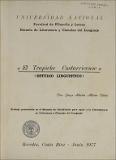| dc.contributor.advisor | Goínza, L. Gastón | |
| dc.contributor.author | Alfaro Pérez, Jorge Alberto | |
| dc.date.accessioned | 2020-11-09T21:27:17Z | |
| dc.date.available | 2020-11-09T21:27:17Z | |
| dc.date.issued | 1977 | |
| dc.identifier.other | 000093252 | |
| dc.identifier.uri | http://hdl.handle.net/11056/18574 | |
| dc.description.abstract | Analiza el léxico referente al trapiche de la región central de Costa Rica, con la finalidad de recolectar material lingüístico en la actividad agrícola y artesanal, conocer la infraestructura económica del trapiche y su situación actual, diferenciar la generacional y de géneros en relación con la lengua funcional y realizar un aporte al estudio del español hablado en Costa Rica. La metodología de investigación se utiliza el método de la geografía lingüística, en un sentido etnográfico y ergológico. A su vez, requiere de la cartografía como medio de presentación. El objeto de estudio son las regiones de Heredia y Alajuela y los sujetos son hombres de 40 años en adelante. Los instrumentos de recolección de datos que se utilizaron son el cuestionario y la entrevista, y se analizaron los datos mediante el sistema de transcripción el alfabeto fonético de la Revista de Filología Española. Dentro de las conclusiones, se obtuvo que los objetivos planteados se detalla la importancia que tenían los trapiches en la región central costarricense, la adaptación de los hombres para continuar con su vida y el cambio de su lenguaje laboral. | es_ES |
| dc.description.abstract | It analyzes the lexicon referring to the trapiche of the central region of Costa Rica, with the purpose of collecting linguistic material in the agricultural and artisan activity, to know the economic infrastructure of the trapiche and its current situation, to differentiate the generational and gender in relation to the functional language and to make a contribution to the study of the Spanish spoken in Costa Rica. The research methodology uses the method of linguistic geography, in an ethnographic and ergonomic sense. In turn, it requires cartography as a means of presentation. The object of study is the regions of Heredia and Alajuela and the subjects are men from 40 years of age and older. The instruments of data collection used are the questionnaire and the interview, and the data were analyzed through the system of transcription of the phonetic alphabet of the Journal of Spanish Philology. Within the conclusions, it was obtained that the objectives raised were the importance that the trapiches had in the Costa Rican central region, the adaptation of the men to continue with their life and the change of their labor language. | es_ES |
| dc.description.sponsorship | Universidad Nacional, Costa Rica | es_ES |
| dc.language.iso | spa | es_ES |
| dc.publisher | Universidad Nacional, Costa Rica | es_ES |
| dc.rights | Acceso abierto | es_ES |
| dc.rights | Attribution-NonCommercial-NoDerivatives 4.0 Internacional | * |
| dc.rights.uri | http://creativecommons.org/licenses/by-nc-nd/4.0/ | * |
| dc.subject | LENGUAJE | es_ES |
| dc.subject | LINGÜÍSTICA | es_ES |
| dc.subject | COSTA RICA | es_ES |
| dc.subject | LANGUAGE | es_ES |
| dc.subject | LINGUISTIC | es_ES |
| dc.title | El trapiche costarricense: estudio lingüístico | es_ES |
| dc.type | http://purl.org/coar/resource_type/c_7a1f | es_ES |
| una.tesis.numero | 0607 | es_ES |
| dc.description.procedence | Escuela de Literatura y Ciencias del Lenguaje | es_ES |


